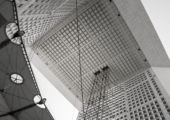January 23, 2013
Designing for productivity means creating space for us to be alone
 On the face of it, the case for working in open plan offices is clear cut. Not only are they more conducive to collaborative work and less bound by ideas of that great no-no that we used to call ‘status’, the economic case is seemingly open and shut. Open plan workstations not only take up around half the space of cellular offices, the fit-out costs are typically 25 per cent lower. And yet there are clear signs of a backlash, at least to the idea of them fostering collaborative work.
On the face of it, the case for working in open plan offices is clear cut. Not only are they more conducive to collaborative work and less bound by ideas of that great no-no that we used to call ‘status’, the economic case is seemingly open and shut. Open plan workstations not only take up around half the space of cellular offices, the fit-out costs are typically 25 per cent lower. And yet there are clear signs of a backlash, at least to the idea of them fostering collaborative work.
This was the subject of a survey of 90,000 people by architects Gensler which found that ‘the most significant factor in workplace effectiveness is not collaboration, it’s individual focus work.’ Conversely, the report also concludes that ‘focus is also the workplace environment’s least effectively supported activity.’
The results echo earlier research. A study of 13,000 employees carried out in the US by BOSTI Associates in 2001 found that the single most important factor in determining productivity was ‘the ability to do distraction-free solo work’.
So, as far as offices are concerned, hell is definitely other people. It is other people that are most likely to be the source of distractions, acoustic, visual and even olfactory. Seemingly there isn’t a sensory nerve you possess that somebody else can’t get on. Mobile phone ring tones regularly top surveys of the most annoying things in offices, followed by smelly food, body odour, irrelevant conversation, equipment noise and other people generally.
What is interesting about the research in this area is that the things that cause the most stress, annoyance and distraction are those that are either irrelevant or over which people have no control. For example, the Scandinavian researchers Anders Kjellberg and Bertil Nordstrom found in one of their studies that sudden noise was far more distracting than constant background noise. They also found that the noise of printers and shredders is only really annoying for the people not using the equipment. The same researchers also recount research that shows that colleagues’ speech is more of a problem when it is unintelligible or irrelevant.
According to a report from the Commission for Architecture and the Built Environment (CABE – now merged with the Design Council), people enjoy a 38 per cent improvement in their ability to perform many tasks if they work in a workplace where acoustic conditions have been optimised. The same survey also reported that people perform 16 per cent better in memory tests and 40 per cent better in mental arithmetic tests, when they aren’t disrupted by undue noise. Other reports go even further. A study published in the British Journal of Psychology has highlighted the role that ‘irrelevant noise’ plays not only in disrupting work, but also in increasing stress levels and decreasing job satisfaction.
Little wonder that there has always been a tug back towards the cellular office since we first developed the principles of the modern office in the early part of the 20th Century. A lot of the time – both now and in the past – this hankering for four walls and a door has been a matter of status, but there are some very good reasons why people may want to lock themselves away that are nothing to do with their place in the hierarchy.
Even for those workers not afforded the luxury of working from home, spatial requirements have changed, thanks to the death of CRT monitors and the now ubiquitous use of the flat screen VDU which have reduced individual workstation footprints by over 20 percent, allowing firms to fit more and more people into the same space. As a result of such developments, the typical space allocated to an individual in a building has shrunk dramatically in the last few years, while the provision of public and meeting space has increased.
But, just because getting more people into a building is easily achievable, is it the right thing to do? The ‘father’ of proxemics, which is the study of personal space, cultural researcher Edward T Hall, claimed that people typically have up to four zones of comfort. These are dependent on the level of intimacy with the other person, and are classified as ‘intimate’, ‘personal’, ‘social’ and ‘public’.
Get these wrong and you add to the stress people feel about being around their fellow humans. It’s important to know where to draw the line and even make sure you’re well short of it just in case.
So with all the stress associated with work and in particular with other people, is there any wonder that people yearn for some privacy? The problem can become exacerbated when you consider the genuine need that some staff have for confidentiality and to meet their own psychological needs.
The psychology of collaborative work has been the subject of a series of events delivered by Mark Catchlove of Herman Miller’s Insight Group in conjunction with researcher Nigel Oseland. They draw on their own ideas as well as those of authors and speakers such as Susan Cain to show how supposedly collaborative working environments based on throwing everybody together are not only unconducive for particular tasks, but favour certain types of people more than others.
In part the solution they suggest is a variety of spaces and an awareness that organisations should not be modelled around the extroverts who make the most noise. This model of the workplace based on task-oriented zones is not new and dates back at least to the time of the combi-office, a mixture of cellular and open plan, that was a common feature of European offices long before we even knew what a laptop was, and was adopted in the US including by firms such as Steelcase who labelled their own take on the idea as ‘Caves and Commons’.
The key difference nowadays is that while the combi-office was frequently specified as part of a hierarchical vision of work, with cellular offices going with status as part of a relatively rigid layout, modern organisations prefer their displays of status to be a bit less obvious. They certainly need their offices to be far more flexible, even fluid.
So the provision of zones for private and interactive work nowadays will typically be far more dependent on function and need than on status. Because of this close link with functionality, this relatively complex model of the workplace is invariably reliant on a thorough understanding of the organisation’s needs as well as those of the people who work for it. This understanding starts from the basic premise that while there may be a good economic argument for the open plan and an admission that some privacy must be sacrificed in the interests of communications, there is a tug back in the other direction that has its own logic and its own business case. The challenge is to get the balance right.
These developments are also manifest in the designs of individual products. Last year’s Orgatec was a dead giveaway in that it had a whole hall dedicated to acoustics and the theme was evident throughout the rest of the show too as the pictures illustrating this feature show. It was intriguing to see how some of the newer furniture systems designed to provide acoustic privacy had more than a whiff of the panel system about them. They were supposed to be consigned to history but are cubicles on the way back already?
Similarly there was ongoing interest in how to make the public spaces in buildings work better. So there was lots of talk of soft seating and quiet time, as well as more traditional public spaces such as receptions and break out spaces. Again this is linked to the increasingly peripatetic nature of the workforce and the need to accommodate people physically in a building as well as giving them space to work quickly and easily and in the way that suits them as individuals. In doing so, we can expect a move away from the simplistic notion that collaboration makes people more productive and the best way to achieve that is to expose them to each other in an open plan office.




















January 23, 2013 @ 3:06 pm
Good stuff Mark, very insightful. I will recommend it widely.
January 26, 2013 @ 3:27 pm
This is a very well done article. Thank you.
I’d offer a couple of observations.
We seem to still talk in binary terms – open or closed – and frame this as a debate with a right or wrong answer. Haven’t we learned that there are several types of work that we do, and that there are appropriate settings for each of those modes? The problems and issues of open and closed seem to stem mostly from places where the choices of settings are limited and where people are assigned to a single work setting that compromises the effectiveness of almost anything they do.
When we frame the question as a matter of binary choice, we also shift the discussion from what we’ve learned about the purpose of the workplace – bring people together to work together – to its style. So even in cases where designers have achieved a more varied workplace, the settings are provided with cute and superficial names. We’ve provided components out of a catalog of style, of sorts, rather than engaging organizational leadership and management in a critical review of the evolving and dynamic nature of work and how good design contributes rather than hinders the performance of people in the organization.
It seems important for us to read these articles and collect the listing of faults and complaints as an agenda for critical design thinking. For example, a poor acoustic environment is not overcome by higher cubicle walls, and the performance of the organization is not served by putting people behind doors, either. Solve the acoustical problem, first.
January 27, 2013 @ 10:26 am
Jim, those are great points. It’s a complex issue. One of our writers pointed out that one of the complicating factors is that the solution to many workplace problems is as much about good management as it is good design. I think one of the underlying issues is that the debate is framed by people with vested interests. So if you make screens or panels, it’s in your commercial interest to promote the idea that the solution to poor acoustics and a lack of privacy is a screen. I think a related problem is that when people talk about ‘The Office of the Future’ as they do quite a lot, they tend to mean ‘The Office of the Future for Those Sectors that like Quirky Designs’ because it’s more interesting. For most people changes in the way their surroundings are designed tend to evolve in a nuanced way rather than involve being asked to work in perspex pods and get between floors of the building on a slide.
January 27, 2013 @ 8:44 pm
Your point is a very good one, Mark. Discussions of “The office of the future” always seem to need a modifier or qualifier, of sorts – “…for creative professions,” or “…for financial services,” or “…for code writers.”
We are doing more of this ourselves in some of our recent work, testing both the universality as well as the uniqueness of designs in response to different kinds of work. We are speculating now on what we are tentatively calling “the technical workplace” where the presence of the product, the scale of the media and technology of work, the asynchronous needs for collaboration and connection among different disciplines, and other considerations seem to demand that more “nuanced” approach you propose.
Thanks again for your helpful and thought-provoking article.
A train that symbolises the clash of old and new ways of work
January 28, 2013 @ 7:11 am
[…] We all know that, unless we book a seat during half-term, the train can provide exactly the sort of focussed work environment conducive to getting some proper work done. In fact the whole country might be a whole lot more productive and happier if we slowed the […]
February 2, 2013 @ 3:13 pm
Thought provoking article. Offices are designed often times by “teams” within a company along with design professionals. When finished its as if they deliver a new gadget with no owners manual! Managers have to be trained how to use the space. How to make it fit their purposes. What is the design intent? How is this supposed to help us meet our business goals? And most importantly – the office is a live, organic, ever changing environment. Change it! Almost everyone instead make the people or the function fit the space instead of the other way around.
February 2, 2013 @ 3:20 pm
Matt
We’re currently carrying out a survey into the experience and attitudes of facilities managers and from the responses we’ve had so far, they make you dead right. The approach is obviously to get the horse in front of the cart.
February 6, 2013 @ 6:52 am
Matt – the problem can be just as great from the other end. As the design team we may not have access to the user groups for a variety of reasons from corporate structure, to cost or time. Ideally the new office space should be designed to align with business goals but many “purchasers” of design don’t understand how to include this in their brief or who from the organization should be involved. When significant change is involved the best outcomes usually require a change management approach covering both the design and the business together.
Video: Why designers need to design for our ears too
February 10, 2013 @ 9:36 pm
[…] ignored but about which we now have a great deal of research is that of acoustic comfort. Insight has covered the subject before, but the fact remains that too often we design for our eyes far more than our ears. What we also […]
This is not the Office of the Future
February 13, 2013 @ 9:26 am
[…] accountants, but also in more generally acceptable facets of office designs such as the open plan. There are signs of a backlash to the undue focus on design solely for extroverts but many of these reports promote values that […]
This is not the office of the future « SourceYour | So You Know Better
February 14, 2013 @ 7:25 am
[…] also in more generally acceptable and widespread facets of office design such as the open plan. There are signs of a backlash to the undue focus on design based primarily on the needs of extroverts but many of these reports […]
What Aldous Huxley can teach us about acoustics at work
March 4, 2013 @ 5:23 am
[…] the person responsible for the TED Talk presented below. But she is not alone, as we suggested in this recent feature. The message isn’t new. Nearly 70 years ago, Aldous Huxley bemoaned the din of technology in […]
HS2 - still a train that symbolises the clash of old and new ways of working - Office Insight
May 16, 2013 @ 5:57 am
[…] that, unless we’ve booked a seat during half-term, the train can provide exactly the sort of focussed work environment conducive to getting some proper work done. In fact the whole country might be a lot more productive and happy if we actually slowed the […]